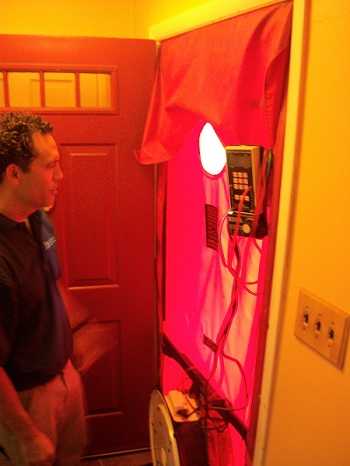Before I caved and signed up for an energy audit, I had my own, inexpert opinion about how our house lost so much energy. I knew that it did: The house was built (hastily) as military housing back in 1941 and still has its original single-pane windows. Neighbors joke about how leaky the units in our townhouse complex are. Most of us get drafts in the winter, and our second floors can be hot and stuffy in summer months.
In the thermal image in my head, I pictured energy leaking out around the old windows and doors; escaping up the attic and hissing through cracks in the front wall. Trying to contain it seemed like carrying water in a bucket pocked with holes.
Several months ago, I noticed a guy carrying some heavy-duty equipment out of my neighbor’s house. He introduced himself as Jonathan Ferree from ecobeco and gave me his card. Did I know that an energy audit would cost only $100, thanks to a rebate from my utility? You’d think I would have, working for an energy efficiency nonprofit–but it was news to me. A few months passed, and Jonathan’s card sat on my desk; I had put the task “Call for energy audit” on my to-do list, where it stayed.
Getting in My Own Way
I probably acted out every behavior that trips people up when they want to curtail their energy use: inertia, forgetfulness, procrastination (“I’ll do this next month”), excuse-making (“We can’t afford to replace the heat pump just now”) and even finger-pointing (“We live in a small house, not a big McMansion–they’re the energy-guzzlers”).
Finally, I stopped to reflect on this, and picked up the phone.
However, I had one more hurdle to get past: it turned out that the first part of the audit was my responsibility. I had to fill out a lengthy questionnaire about our HVAC equipment, appliances, lighting, and my family’s energy use. I can think of better ways to spend an afternoon than writing down the wattage of every light bulb in the house. But I did it, and a week or so later, Jonathan showed up.

Problem Areas
We did a full walk-through of the house, and Jonathan–a Building Performance Institute (BPI)-certified auditor–pointed out problem areas like the uninsulated slope on one side of the attic. The single-pane windows I’d imagined to be such energy sinks were not, in his view, such a big problem. They’re reinforced by storm windows, which boost their efficiency. Jonathan did point out that, at three tons, our heat pump is probably too big for our 1,100-square-foot townhouse. This is common: contractors often install bigger pumps to be “on the safe side” functionally, but the systems end up using more energy than they ought to.
When he turned on the blower door, both of the cats made a run for it. “Come over here,” Jonathan said, and I joined him by the French doors leading to the patio. He had his hand over the seam where the top of the door frame joins the wall–a seam I’d never noticed before, since it’s above my eye level.
I raised my hand, and felt air streaming in from outside. Energy efficiency is invisible, but a blower-door test makes it tangible: I could feel the inefficiency with my own hands.
Next: the auditor’s report comes in and the numbers aren’t pretty.